Microsoft's Competitive Strategies: Cost Leadership, Differentiation
VerifiedAdded on 2020/05/04
|5
|1070
|189
Essay
AI Summary
This essay examines Microsoft's strategic approaches, focusing on cost leadership and differentiation as key drivers of its competitive advantage. It analyzes Microsoft's use of mergers and acquisitions to enhance its market position and explores its international strategy, which employs a centralized approach while adapting to local markets. The essay also discusses Microsoft's diversified corporate strategy, highlighting the profitability of its Windows and Microsoft Business divisions, and its commitment to social responsibility through initiatives in human rights, transparency, and environmental sustainability. Finally, it identifies major competitors such as Apple, Google, IBM, and Oracle, underscoring the intense competition in the technology sector. Desklib provides access to similar solved assignments and study resources for students.
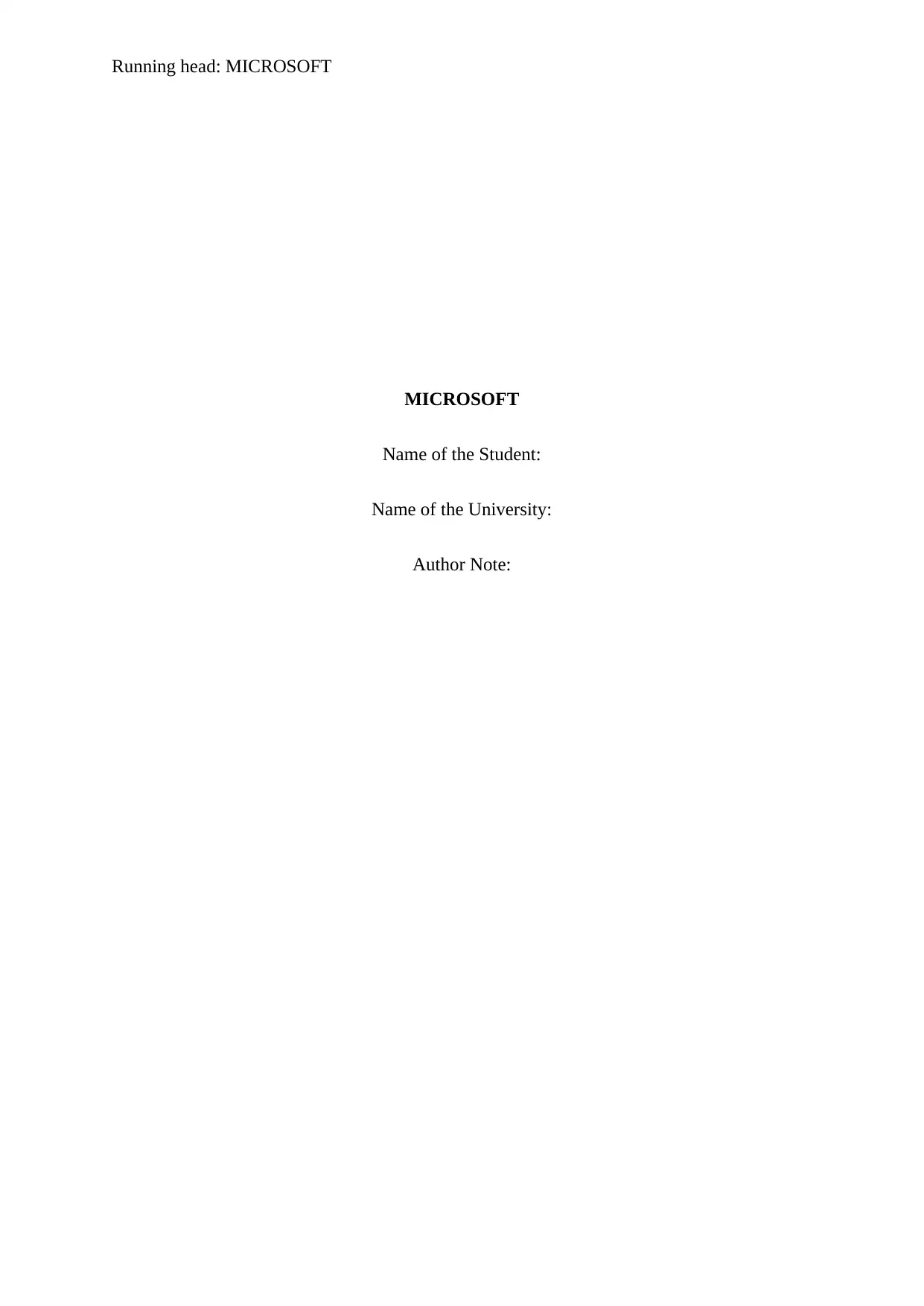
Running head: MICROSOFT
MICROSOFT
Name of the Student:
Name of the University:
Author Note:
MICROSOFT
Name of the Student:
Name of the University:
Author Note:
Paraphrase This Document
Need a fresh take? Get an instant paraphrase of this document with our AI Paraphraser
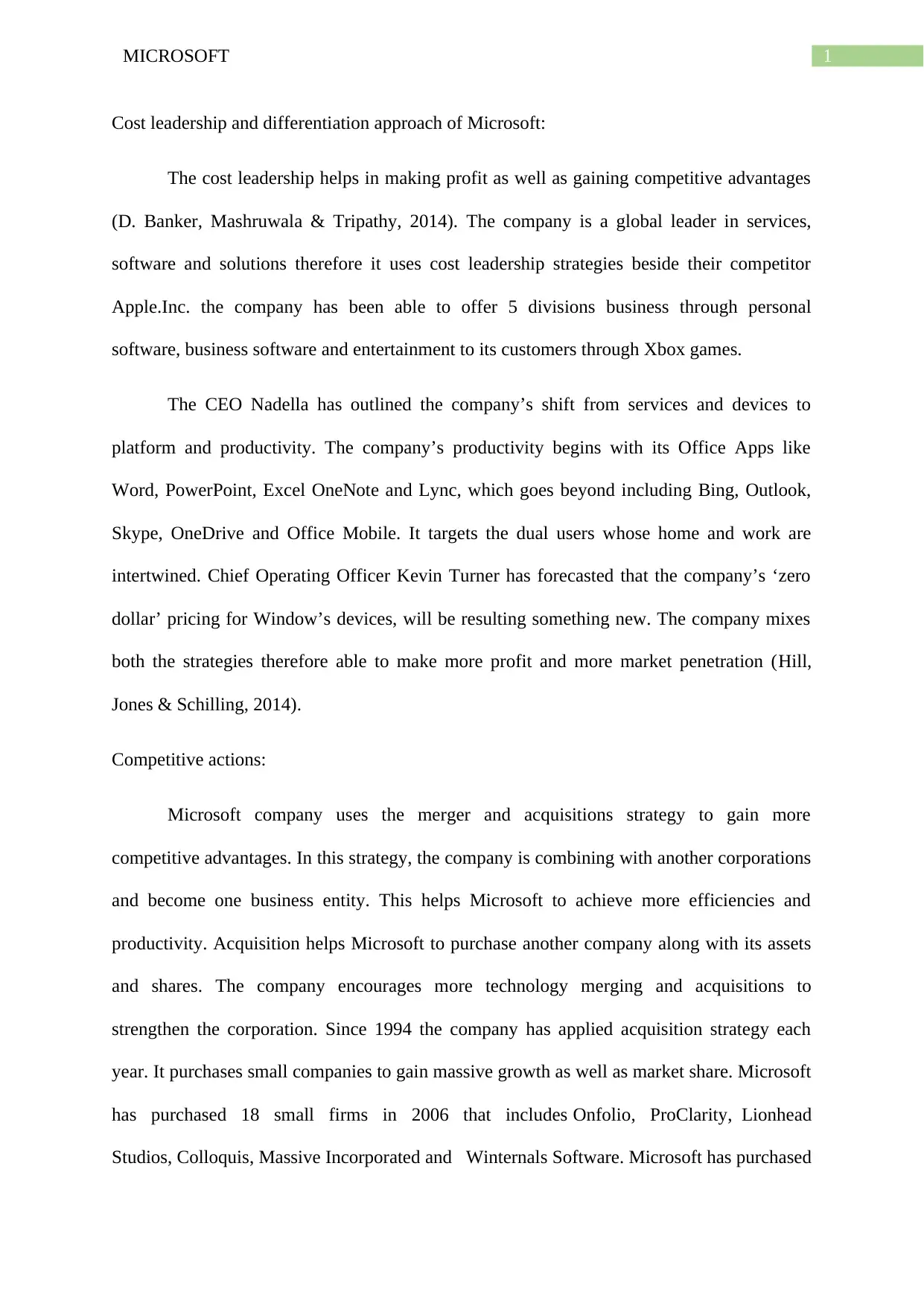
1MICROSOFT
Cost leadership and differentiation approach of Microsoft:
The cost leadership helps in making profit as well as gaining competitive advantages
(D. Banker, Mashruwala & Tripathy, 2014). The company is a global leader in services,
software and solutions therefore it uses cost leadership strategies beside their competitor
Apple.Inc. the company has been able to offer 5 divisions business through personal
software, business software and entertainment to its customers through Xbox games.
The CEO Nadella has outlined the company’s shift from services and devices to
platform and productivity. The company’s productivity begins with its Office Apps like
Word, PowerPoint, Excel OneNote and Lync, which goes beyond including Bing, Outlook,
Skype, OneDrive and Office Mobile. It targets the dual users whose home and work are
intertwined. Chief Operating Officer Kevin Turner has forecasted that the company’s ‘zero
dollar’ pricing for Window’s devices, will be resulting something new. The company mixes
both the strategies therefore able to make more profit and more market penetration (Hill,
Jones & Schilling, 2014).
Competitive actions:
Microsoft company uses the merger and acquisitions strategy to gain more
competitive advantages. In this strategy, the company is combining with another corporations
and become one business entity. This helps Microsoft to achieve more efficiencies and
productivity. Acquisition helps Microsoft to purchase another company along with its assets
and shares. The company encourages more technology merging and acquisitions to
strengthen the corporation. Since 1994 the company has applied acquisition strategy each
year. It purchases small companies to gain massive growth as well as market share. Microsoft
has purchased 18 small firms in 2006 that includes Onfolio, ProClarity, Lionhead
Studios, Colloquis, Massive Incorporated and Winternals Software. Microsoft has purchased
Cost leadership and differentiation approach of Microsoft:
The cost leadership helps in making profit as well as gaining competitive advantages
(D. Banker, Mashruwala & Tripathy, 2014). The company is a global leader in services,
software and solutions therefore it uses cost leadership strategies beside their competitor
Apple.Inc. the company has been able to offer 5 divisions business through personal
software, business software and entertainment to its customers through Xbox games.
The CEO Nadella has outlined the company’s shift from services and devices to
platform and productivity. The company’s productivity begins with its Office Apps like
Word, PowerPoint, Excel OneNote and Lync, which goes beyond including Bing, Outlook,
Skype, OneDrive and Office Mobile. It targets the dual users whose home and work are
intertwined. Chief Operating Officer Kevin Turner has forecasted that the company’s ‘zero
dollar’ pricing for Window’s devices, will be resulting something new. The company mixes
both the strategies therefore able to make more profit and more market penetration (Hill,
Jones & Schilling, 2014).
Competitive actions:
Microsoft company uses the merger and acquisitions strategy to gain more
competitive advantages. In this strategy, the company is combining with another corporations
and become one business entity. This helps Microsoft to achieve more efficiencies and
productivity. Acquisition helps Microsoft to purchase another company along with its assets
and shares. The company encourages more technology merging and acquisitions to
strengthen the corporation. Since 1994 the company has applied acquisition strategy each
year. It purchases small companies to gain massive growth as well as market share. Microsoft
has purchased 18 small firms in 2006 that includes Onfolio, ProClarity, Lionhead
Studios, Colloquis, Massive Incorporated and Winternals Software. Microsoft has purchased
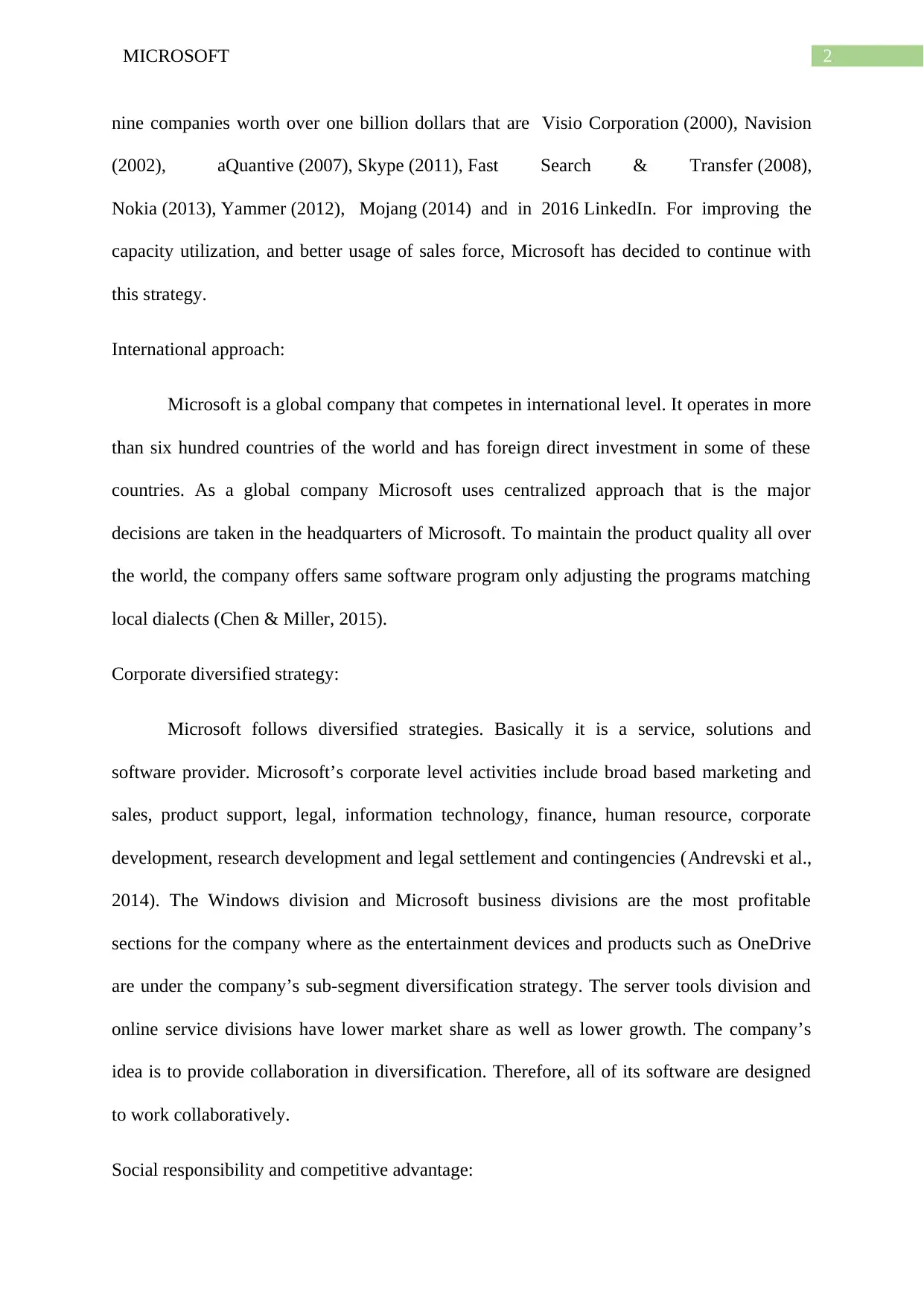
2MICROSOFT
nine companies worth over one billion dollars that are Visio Corporation (2000), Navision
(2002), aQuantive (2007), Skype (2011), Fast Search & Transfer (2008),
Nokia (2013), Yammer (2012), Mojang (2014) and in 2016 LinkedIn. For improving the
capacity utilization, and better usage of sales force, Microsoft has decided to continue with
this strategy.
International approach:
Microsoft is a global company that competes in international level. It operates in more
than six hundred countries of the world and has foreign direct investment in some of these
countries. As a global company Microsoft uses centralized approach that is the major
decisions are taken in the headquarters of Microsoft. To maintain the product quality all over
the world, the company offers same software program only adjusting the programs matching
local dialects (Chen & Miller, 2015).
Corporate diversified strategy:
Microsoft follows diversified strategies. Basically it is a service, solutions and
software provider. Microsoft’s corporate level activities include broad based marketing and
sales, product support, legal, information technology, finance, human resource, corporate
development, research development and legal settlement and contingencies (Andrevski et al.,
2014). The Windows division and Microsoft business divisions are the most profitable
sections for the company where as the entertainment devices and products such as OneDrive
are under the company’s sub-segment diversification strategy. The server tools division and
online service divisions have lower market share as well as lower growth. The company’s
idea is to provide collaboration in diversification. Therefore, all of its software are designed
to work collaboratively.
Social responsibility and competitive advantage:
nine companies worth over one billion dollars that are Visio Corporation (2000), Navision
(2002), aQuantive (2007), Skype (2011), Fast Search & Transfer (2008),
Nokia (2013), Yammer (2012), Mojang (2014) and in 2016 LinkedIn. For improving the
capacity utilization, and better usage of sales force, Microsoft has decided to continue with
this strategy.
International approach:
Microsoft is a global company that competes in international level. It operates in more
than six hundred countries of the world and has foreign direct investment in some of these
countries. As a global company Microsoft uses centralized approach that is the major
decisions are taken in the headquarters of Microsoft. To maintain the product quality all over
the world, the company offers same software program only adjusting the programs matching
local dialects (Chen & Miller, 2015).
Corporate diversified strategy:
Microsoft follows diversified strategies. Basically it is a service, solutions and
software provider. Microsoft’s corporate level activities include broad based marketing and
sales, product support, legal, information technology, finance, human resource, corporate
development, research development and legal settlement and contingencies (Andrevski et al.,
2014). The Windows division and Microsoft business divisions are the most profitable
sections for the company where as the entertainment devices and products such as OneDrive
are under the company’s sub-segment diversification strategy. The server tools division and
online service divisions have lower market share as well as lower growth. The company’s
idea is to provide collaboration in diversification. Therefore, all of its software are designed
to work collaboratively.
Social responsibility and competitive advantage:
⊘ This is a preview!⊘
Do you want full access?
Subscribe today to unlock all pages.

Trusted by 1+ million students worldwide
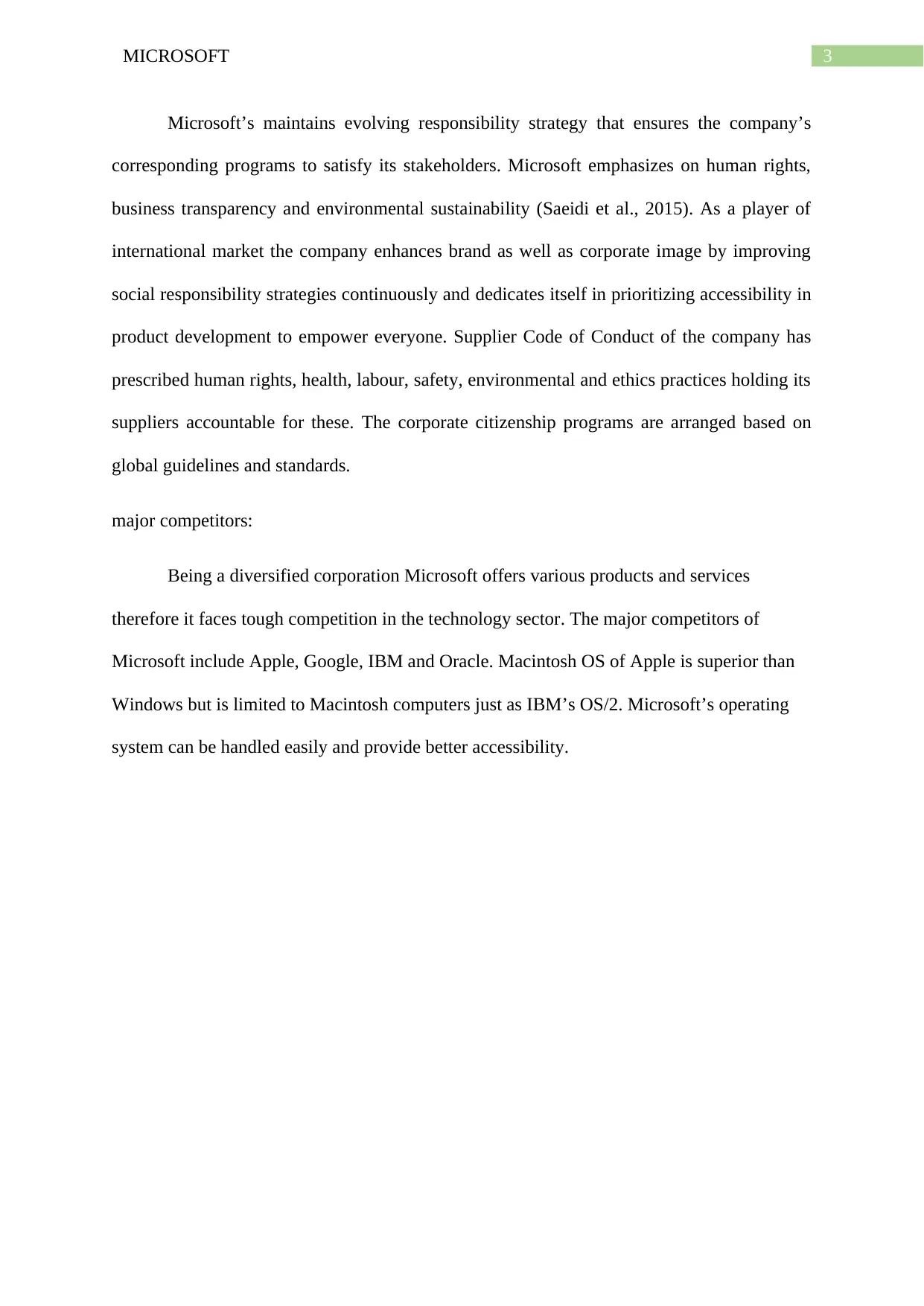
3MICROSOFT
Microsoft’s maintains evolving responsibility strategy that ensures the company’s
corresponding programs to satisfy its stakeholders. Microsoft emphasizes on human rights,
business transparency and environmental sustainability (Saeidi et al., 2015). As a player of
international market the company enhances brand as well as corporate image by improving
social responsibility strategies continuously and dedicates itself in prioritizing accessibility in
product development to empower everyone. Supplier Code of Conduct of the company has
prescribed human rights, health, labour, safety, environmental and ethics practices holding its
suppliers accountable for these. The corporate citizenship programs are arranged based on
global guidelines and standards.
major competitors:
Being a diversified corporation Microsoft offers various products and services
therefore it faces tough competition in the technology sector. The major competitors of
Microsoft include Apple, Google, IBM and Oracle. Macintosh OS of Apple is superior than
Windows but is limited to Macintosh computers just as IBM’s OS/2. Microsoft’s operating
system can be handled easily and provide better accessibility.
Microsoft’s maintains evolving responsibility strategy that ensures the company’s
corresponding programs to satisfy its stakeholders. Microsoft emphasizes on human rights,
business transparency and environmental sustainability (Saeidi et al., 2015). As a player of
international market the company enhances brand as well as corporate image by improving
social responsibility strategies continuously and dedicates itself in prioritizing accessibility in
product development to empower everyone. Supplier Code of Conduct of the company has
prescribed human rights, health, labour, safety, environmental and ethics practices holding its
suppliers accountable for these. The corporate citizenship programs are arranged based on
global guidelines and standards.
major competitors:
Being a diversified corporation Microsoft offers various products and services
therefore it faces tough competition in the technology sector. The major competitors of
Microsoft include Apple, Google, IBM and Oracle. Macintosh OS of Apple is superior than
Windows but is limited to Macintosh computers just as IBM’s OS/2. Microsoft’s operating
system can be handled easily and provide better accessibility.
Paraphrase This Document
Need a fresh take? Get an instant paraphrase of this document with our AI Paraphraser
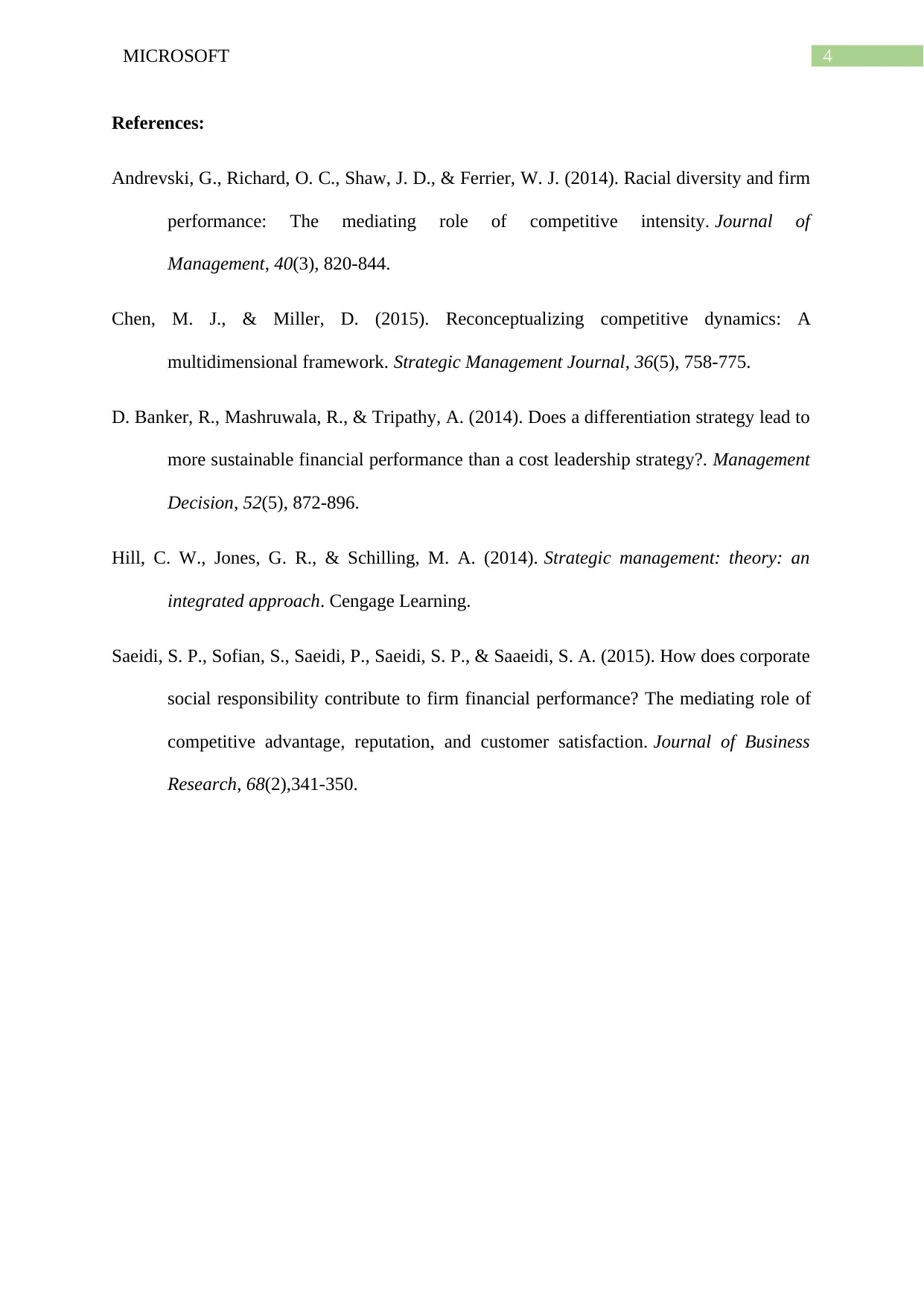
4MICROSOFT
References:
Andrevski, G., Richard, O. C., Shaw, J. D., & Ferrier, W. J. (2014). Racial diversity and firm
performance: The mediating role of competitive intensity. Journal of
Management, 40(3), 820-844.
Chen, M. J., & Miller, D. (2015). Reconceptualizing competitive dynamics: A
multidimensional framework. Strategic Management Journal, 36(5), 758-775.
D. Banker, R., Mashruwala, R., & Tripathy, A. (2014). Does a differentiation strategy lead to
more sustainable financial performance than a cost leadership strategy?. Management
Decision, 52(5), 872-896.
Hill, C. W., Jones, G. R., & Schilling, M. A. (2014). Strategic management: theory: an
integrated approach. Cengage Learning.
Saeidi, S. P., Sofian, S., Saeidi, P., Saeidi, S. P., & Saaeidi, S. A. (2015). How does corporate
social responsibility contribute to firm financial performance? The mediating role of
competitive advantage, reputation, and customer satisfaction. Journal of Business
Research, 68(2),341-350.
References:
Andrevski, G., Richard, O. C., Shaw, J. D., & Ferrier, W. J. (2014). Racial diversity and firm
performance: The mediating role of competitive intensity. Journal of
Management, 40(3), 820-844.
Chen, M. J., & Miller, D. (2015). Reconceptualizing competitive dynamics: A
multidimensional framework. Strategic Management Journal, 36(5), 758-775.
D. Banker, R., Mashruwala, R., & Tripathy, A. (2014). Does a differentiation strategy lead to
more sustainable financial performance than a cost leadership strategy?. Management
Decision, 52(5), 872-896.
Hill, C. W., Jones, G. R., & Schilling, M. A. (2014). Strategic management: theory: an
integrated approach. Cengage Learning.
Saeidi, S. P., Sofian, S., Saeidi, P., Saeidi, S. P., & Saaeidi, S. A. (2015). How does corporate
social responsibility contribute to firm financial performance? The mediating role of
competitive advantage, reputation, and customer satisfaction. Journal of Business
Research, 68(2),341-350.
1 out of 5
Related Documents
Your All-in-One AI-Powered Toolkit for Academic Success.
+13062052269
info@desklib.com
Available 24*7 on WhatsApp / Email
![[object Object]](/_next/static/media/star-bottom.7253800d.svg)
Unlock your academic potential
Copyright © 2020–2025 A2Z Services. All Rights Reserved. Developed and managed by ZUCOL.




